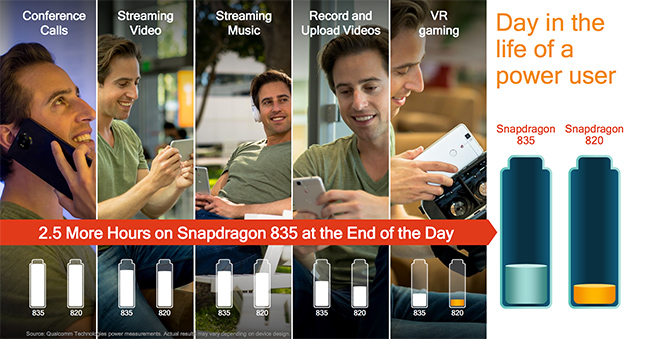The Qualcomm Snapdragon 835 Performance Preview
by Matt Humrick & Ryan Smith on March 22, 2017 4:30 AM EST- Posted in
- Smartphones
- Snapdragon
- Qualcomm
- Mobile
- SoCs
- Snapdragon 835
- Kryo
First Thoughts
Mobile SoCs are packed with specialized processors: CPU, GPU, high-performance DSP (compute), low-power DSP (sensor hub), modem DSP (signal processing), ISP (image processing), fixed-function blocks (video, audio), etc. And while all of these pieces contribute to the overall user experience, some of them are difficult to quantify. The CPU and GPU remain vital to device performance and battery life, so it’s still important to probe their capabilities.
Our initial testing shows that Snapdragon 835’s Kryo 280 CPU is an octa-core, big.LITTLE configuration with four semi-custom A73 “performance” cores and four semi-custom A53 “efficiency” cores. Kryo 280’s performance cores are pretty much equivalent to Kirin 960’s A73 cores in both integer and floating-point IPC, but comparing them to Snapdragon 820’s Kryo CPU shows mixed results: integer IPC improves but floating-point regresses.
In our limited system testing, the Snapdragon 835’s IPC gains outweigh its losses, providing better overall performance than the Snapdragon 820/821 phones. Unsurprisingly, the Snapdragon 835 MDP/S matched the performance of the Mate 9’s Kirin 960, which may not sound all that exciting, but considering our positive experience with the Mate 9, it’s certainly not bad either.
Qualcomm continues to push hard into VR/AR, not just with smartphones but stand-alone HMDs too. The high resolution and low latency requirements for these experiences suddenly make the GPU a bottleneck once again. The Snapdragon 835’s updated Adreno 540 GPU, through a combination of microarchitecture tweaks and a higher peak operating frequency, is another evolutionary step along the VR path, delivering a 25% peak performance boost over Snapdragon 820’s Adreno 530.
As noted earlier, all of these results came from pre-production hardware and software that’s under Qualcomm’s control, so performance could still go up or down once retail units begin shipping; however, based on these preliminary numbers and feature additions, the Snapdragon 835 looks like a solid evolutionary upgrade over the S820. The one glaring omission in this initial assessment, though, is power efficiency, which is critical to both battery life and sustained performance. The potential power savings from the move to 10nm and the CPU swap could have a larger impact on user experience than the small performance gains and new features.













128 Comments
View All Comments
joms_us - Thursday, March 23, 2017 - link
Well not quite 100% to me... Hell knows what background app is making those spikes and not Geekbenchhttp://i.imgur.com/IjBdsOHh.jpg
http://i.imgur.com/6FWmG5Jh.jpg
http://i.imgur.com/IjMsOjIh.jpg
Remember the news about benchmark cheating of Samsung and now Oneplus? What they did are perfectly valid because a worthless app like Geekbench does not measure the true IPC of the SoC if it can't maximize it. You go to Windows world, people will disable CnQ or Speedstep and Powernow just to make sure processor is running at 100% of frequency to measure true IPC.
P.S Thanks for the name of the app, I appreciate it!
realbabilu - Sunday, March 26, 2017 - link
I remember in Windows Pc,is hard to get all cores stay flat at 100% unless I got very good multithread multiprocessor designed program like Ansys or Abaqus. Means its very tough to get/program a software that can utilize all cores stay at 100%.
ah06 - Wednesday, March 22, 2017 - link
Please stop posting, your understanding of SoCs is less than primary school level and you are talking to experts like Andrei........ah06 - Wednesday, March 22, 2017 - link
Why are you on Anandtech? How old are you?Please do not post again
joms_us - Thursday, March 23, 2017 - link
Oh some God from heaven, sorry for stopping by here.lilmoe - Thursday, March 23, 2017 - link
lol, I was literally being sarcastic in my comment. Looks like it stirred a lot of angry replies.- Geekbench does scale well across all cores. That's not the problem. Geekbench sucks as a benchmark for "absolute" performance of the CPU portion of an SoC (or platform like QC likes to call it) that matters for modern workloads. In addition to that, the way it calculates the totals and how the devs decide what sub-score counts more than what is absolute BS. Most of the workloads it tests are rarely dealt with the CPU and more commonly offloaded to co-processors. Yes, even on iOS devices. I find the compute portion of geekbench rather interesting, but it's rarely discussed by anyone.
- CPUs are getting less and less relevant in modern content consumption workloads. Offloading to co-processors, if at all possible, is the way to go. For instance, Intel's latest 7700K CPU (cpu only) pales in comparison to the least efficient 4K encoding/decoding block implementation on any modern platform, including ARM based SoCs. The same goes for image processing/manipulation, audio, speech recognition, security, etc, etc.... You know, the sub-tests that Geekbench performs.
- Interconnect, bandwidth, cache throughput and latency, and Scheduling play a huge part in the multi-core score of a CPU/SoC. Generally, the more cores you have, the harder and more power consuming it is to scale multiple threads across those cores, _especially_ on processors constrained with a 2-4 watt power envelope. Those caches are very power hungry and often limit scaling by 10-20% of ST even on non-power limited CPUs. That percentage is much, MUCH higher on ultra mobile ARM parts.
- In addition to those scaling issues, the Snapdragon 835, similar to Samsung's Exynos and HiSilcon's Kirin SoCs are big.LITTLE multi-cluster configurations. Typically, only 1 of these clusters is high performance, and only when you're running a single or couple of threads would the high performance cores reach their highest clocks. That's by design of ultra-low power, passively cooled parts. The Exynos 8890 gets up to 2.6Ghz in ST and 2.2Ghz in MT. Again, in addition to clock variance, you'll never get 8x ST since only 4 of those 8 cores are high performance. The smaller cores are nowhere near as powerful. I say they would count as Intel's virtual threads in their hyper threading (SMT), and should help to achieve better scaling by just a tiny bit.
So, yea. I was being sarcastic. I agree with Qualcomm. These modern ARM SoCs are very sophisticated and tricky to benchmark. Nothing about them is simple. What ultimately matters is how much time it takes them to complete a modern workload, and how much power they consume at that. The more of these workloads are offloaded to co-processors, the better.
For the CPU portion, what matters in a smartphone/tablet, first and foremost, is multi-core performance, and how much of that performance is sustained over time with the least amount of power consumption. ST performance is overrated doesn't matter, AT ALL, after a certain performance threshold IN MOBILE DEVICES. Split second javascript gains as a result of browser optimization or real ST lead of a particular SoC are irrelevant. Javascript doesn't exist in a vacume, it's part of a web page/app, and how long it takes a browser to fully load a page and render its content is what ultimately matters. Period.
tuxRoller - Thursday, March 23, 2017 - link
"I find the compute portion of geekbench rather interesting, but it's rarely discussed by anyone."Why is that the case?
Btw, this is a much better comment.
What you are saying is why relevant benchmarks don't exist for mobile devices (sub-laptops).
The issue, i believe, is that sites, largely, test these devices like small computers (bear with me). As such, they focus on cpu related tasks. Some sites include video recording/playback power usage, but none, tmk, include task traces that are taken from someone actually using a device.
tuxRoller - Wednesday, March 22, 2017 - link
If all you care about is a running a headless server that can't communicate with the outside world, then, yeah!If you care about battery life and good performance, low power processors (microcontrollers or tiny a series cores used for handling interrupts or more general duties when in a low power state), dsps and gpus matter.
Do we need a hashtag?
prisonerX - Wednesday, March 22, 2017 - link
Yeah those graphics co-processors, what a joke.wardrive2017 - Wednesday, March 22, 2017 - link
Again I am impressed by the Snapdragon 625 showing here in the cpu tests, particulary in the PC mark tests, not so much in the Javascript. Still performing much better than expected. The G5 plus is starting to look quite appealing assuming its tweaked the same ways the Moto z play is